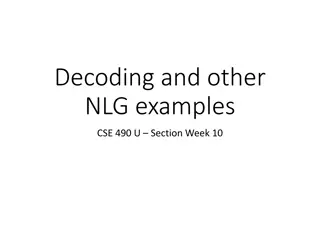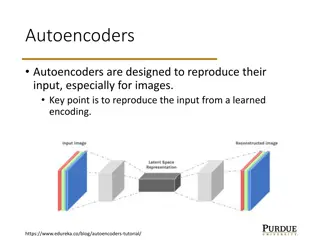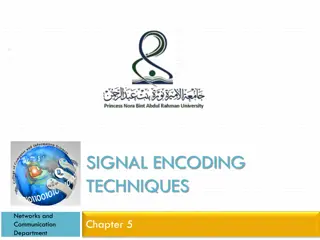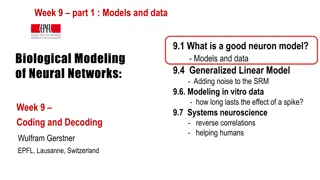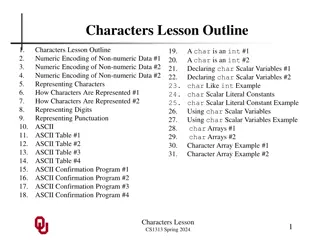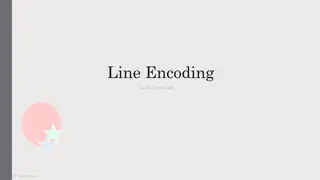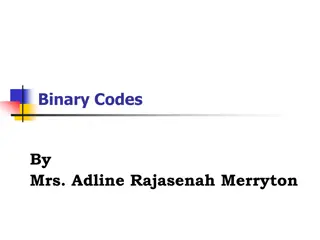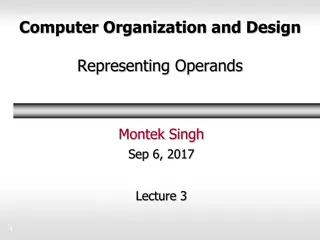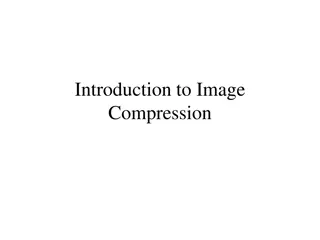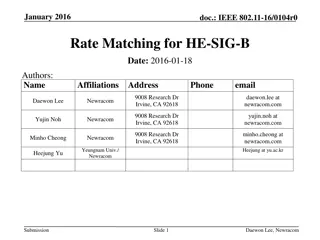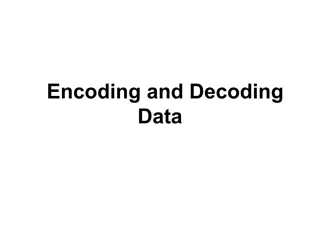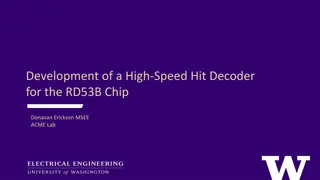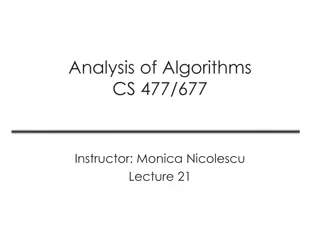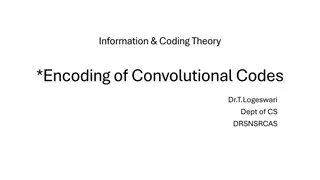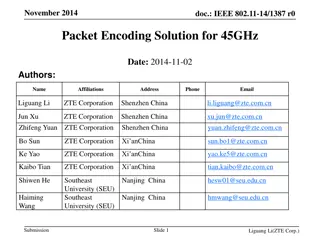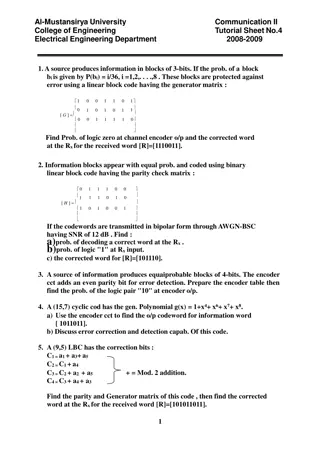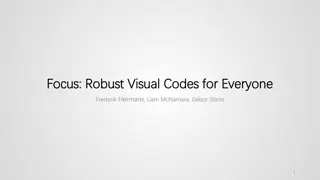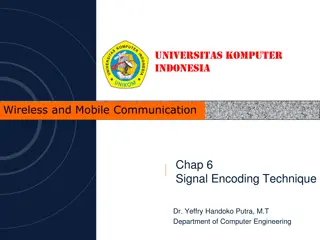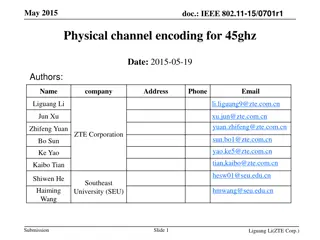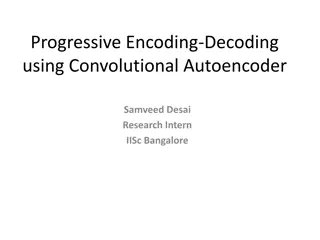Decoding and NLG Examples in CSE 490U Section Week 10
This content delves into the concept of decoding in natural language generation (NLG) using RNN Encoder-Decoder models. It discusses decoding approaches such as greedy decoding, sampling from probability distributions, and beam search in RNNs. It also explores applications of decoding and machine tr
2 views • 28 slides
Variational Autoencoders (VAE) in Machine Learning
Autoencoders are neural networks designed to reproduce their input, with Variational Autoencoders (VAE) adding a probabilistic aspect to the encoding and decoding process. VAE makes use of encoder and decoder models that work together to learn probabilistic distributions for latent variables, enabli
10 views • 11 slides
EEG Conformer: Convolutional Transformer for EEG Decoding and Visualization
This study introduces the EEG Conformer, a Convolutional Transformer model designed for EEG decoding and visualization. The research presents a cutting-edge approach in neural systems and rehabilitation engineering, offering advancements in EEG analysis techniques. By combining convolutional neural
1 views • 6 slides
Enhancing HARQ Framing for IEEE 802.11 Standards
Hybrid-ARQ (HARQ) is a candidate topic for TGbe presentations in IEEE 802.11 standards. Despite previous unsuccessful attempts, there is renewed interest in enabling HARQ through framing support. This document discusses the importance of presenting HARQ framing, outlining the necessary information a
1 views • 7 slides
Signal Encoding Techniques in Networks and Communication
This chapter delves into signal encoding techniques used in digital data transmission, covering key concepts such as encoding schemes like NRZ-L and NRZI, multilevel binary encoding, and biphase encoding. It explores the fundamentals of digital signaling, modulation techniques, and the relationship
9 views • 34 slides
Biological Modeling of Neuronal Networks: Insights from Neural Dynamics
Exploring neuron models, generalized linear models, and decoding processes in neural networks through intracellular and extracellular recordings, with a focus on processing models, encoding, and decoding of spike trains. The Spike Response Model and likelihood of spike trains are discussed, providin
2 views • 32 slides
Numeric and Character Encoding in Programming
In the world of programming, numeric encoding is used to represent non-numeric data for various purposes. This includes encoding different entree options or characters in a natural language using fixed numeric values. Understanding how characters are represented numerically is crucial for efficient
1 views • 31 slides
Decoding Uncertainty in Communication: Exploring Prior Distributions and Coding Schemes
Delve into the intricate world of communication under uncertainty, where decoding messages accurately is paramount. Discover how prior distributions, encoding schemes, and closeness metrics influence the efficiency and effectiveness of communication between parties sharing different priors.
2 views • 22 slides
Line Encoding Lab 6 - 2019/1440: Polar NRZ-L, RZ, and MAN Techniques with Decoder
Explore the Line Encoding Lab 6 from 2019/1440, featuring Polar NRZ-L, RZ, and MAN techniques with decoders. Dive into Simulink settings and output results for each encoding method. Discover how to modify binary number generators and pulse generators to enhance encoding. Conclude with a thank you me
7 views • 14 slides
Binary Codes and Character Coding Techniques
Binary codes, such as ASCII and EBCDIC, are crucial in representing data in computers and digital systems. They play a key role in error detection and data encoding. This article discusses the basics of binary coding, various types of binary codes, character coding techniques like ASCII and EBCDIC,
21 views • 22 slides
Theory of Computation: Decidability and Encoding in CSE 105 Class
Explore the concepts of decidability, encoding, and computational problems in CSE 105 Theory of Computation class. Learn about decision problems, encodings for Turing Machines, framing problems as languages of strings, and examples of computational problems and their encodings. Gain insights into th
6 views • 26 slides
Information Encoding in Computer Organization and Design
Discussions in this lecture delve into the importance and methodology of representing operands in computer systems, covering topics such as encoding characters, integers, positive and negative numbers, fixed-point and floating-point numbers. The motivation behind using binary representation is explo
2 views • 35 slides
Image Compression Techniques
Image compression is essential for reducing file sizes without significant loss of quality. This article explores three common techniques: Run-Length Encoding, Arithmetic Encoding, and their applications in data compression. Learn about encoding intervals, probability ranges, and decoding processes
1 views • 33 slides
January 2016 IEEE 802.11-16/0104r0: Rate Matching for HE-SIG-B
The document from January 2016 focuses on rate matching for HE-SIG-B in IEEE 802.11-16/0104r0 standard. It delves into the encoding/decoding structure, example of SIG-B with code-rate, MCS table, proposed encoding method for HE-SIG-B, and the structure of HE-SIG-B per-STA information field. The cont
0 views • 10 slides
Encoding and Decoding Data Principles
Data encoding involves converting information into a different form using specific rules, which is then decoded back to its original state. This process is crucial for secure communication, as seen in examples like Morse Code. Through encoding, messages can be kept confidential and accessed only by
4 views • 7 slides
High-Speed Hit Decoder Development for RD53B Chip
Development of a high-speed hit decoder for the RD53B chip by Donavan Erickson from MSEE ACME Lab, focusing on data streams, hitmap encoding, ROM splitting, decode engine building, and more. The process involves encoding methods, ROM setup with borrowed software look-up tables, and buffer systems fo
2 views • 33 slides
Attention Mechanism in Neural Machine Translation
In neural machine translation, attention mechanisms allow selective encoding of information and adaptive decoding for accurate output generation. By learning to align and translate, attention models encode input sequences into vectors, focusing on relevant parts during decoding. Utilizing soft atten
1 views • 17 slides
MODERN VIDEO CODECS
MPEG-4 AVC/H.264 is a video codec developed jointly by ISO MPEG and ITU-T VCEG, reaching international standardization in 2003 with subsequent updates until 2007. It is conceptually divided into Video Coding Layer (VCL) for video encoding/decoding and Network Abstraction Layer (NAL) for transporting
1 views • 33 slides
SIMD-Based Decoding of Posting Lists
SIMD-Based Decoding of Posting Lists by Alexander A. Stepanov, Anil R. Gangolli, Daniel E. Rose, Ryan J. Ernst, Paramjit Oberoi discusses efficient methods for decoding posting lists by replacing IDs with deltas, utilizing vbyte and Byte Aligned formats, and exploring byte-oriented encodings. The pa
2 views • 17 slides
Scientific Breakthroughs in the Classroom - Decoding Disk DNA Book 2
Dive into the innovative world of scientific breakthroughs with the Decoding Disk DNA Book 2. Unravel the mysteries of DNA and explore the fascinating process of decoding genetic sequences. Follow along as you decipher the code and uncover the hidden letters within the DNA code. This interactive lea
4 views • 8 slides
Huffman Codes for Data Compression: Analysis and Implementation
Huffman codes are a widely used technique for data compression, assigning binary codes to characters based on their frequency of occurrence. This lecture series delves into fixed-length codes, variable-length codes, and prefix codes, explaining their optimization and implementation for efficient dat
3 views • 31 slides
Introduction to Binary Encoding and Huffman Coding
In this information systems and network engineering overview, delve into the world of binary encoding, Morse code, bits, bytes, and coding. Understand the principles of encoding objectives, prefix properties, code optimization, and Huffman coding. Explore how codes are optimized, symbols are represe
5 views • 16 slides
Content Analysis in Communication Research
Explore the concept of content analysis in communication research, a method bridging quantitative and qualitative approaches to analyze communication media. Discover how qualitative data is transformed into quantitative data to reveal trends and changes, though correlating fine variables can be chal
1 views • 19 slides
Encoding and Decoding of Convolutional Codes in Information Theory
In the realm of information and coding theory, Convolutional Codes serve as error-correcting codes essential for digital communication systems. This article delves into the encoding and decoding processes of Convolutional Codes, highlighting their significance in transmitting continuous data streams
4 views • 38 slides
IEEE 802.11-14/1387.r0 Packet Encoding Solution for 45GHz
Explore the proposed packet encoding solution detailed in the November 2014 document for IEEE 802.11-14/1387.r0. The solution addresses traditional packet processing challenges, enhancing reliability for ultra-high-speed data and video transmission in 802.11aj through a strategic encoding procedure
2 views • 14 slides
Network Fundamentals: Physical Layer and Encoding Techniques
Explore the physical layer of network fundamentals, focusing on encoding bits across a medium, digital vs. analog representations, challenges faced, and solutions like NRZ and NRZI encoding techniques. Dive into clock synchronization, efficiency tradeoffs, and Ethernet encoding strategies for high-s
1 views • 10 slides
Error Correction and Detection Techniques for Digital Communication
Explore various error correction and detection methods in digital communication systems, including linear block codes, cyclic codes, and systematic codes. Learn about encoding, decoding, syndrome calculation, and the application of Hamming bounds for error analysis. Dive into topics like generator a
3 views • 6 slides
Innovative Focus: Robust Visual Codes for Diverse Captures
Explore the innovative approach of Focus, addressing the challenge of designing visual codes robust in various capture conditions. Through unique encoding in the frequency domain, these codes provide improved data transmission and decoding efficiency. Dive into the concepts of Fourier Transform, eff
1 views • 19 slides
Signal Encoding Techniques for Wireless Communication Systems
Explore the importance of signal encoding techniques in wireless communication systems, including reasons for choosing encoding methods, criteria for successful signal interpretation, and comparison of different encoding schemes. Learn how encoding influences data transmission efficiency and signal
4 views • 49 slides
Huffman Encoding and Priority Queue in Computer Science
Learn about Huffman encoding, priority queues, and ASCII encoding for efficient data representation in computer systems. Explore how encoding and decoding work, along with examples to deepen your understanding of these concepts.
5 views • 31 slides
Byte-Oriented Encodings: A Comprehensive Overview
Explore the world of byte-oriented encodings with a focus on efficient storage methods for posting lists and integer representations. Learn about vbyte format, byte-oriented encoding definitions, descriptors, and dimensions of encodings. Delve into a taxonomy of byte-oriented encodings and understan
4 views • 17 slides
Enhancing Physical Data Transmission through Encoding Schemes
Explore the encoding schemes for improving physical data transmission in millimeter-wave communication. Discussing the importance of encoding for channel quality, this document delves into new strategies like SIG and Data encoding to enhance performance. Delve into the specifics of encoding SIG and
4 views • 21 slides
Progressive Encoding-Decoding Using Convolutional Autoencoder - Research Internship Insights
Explore the innovative research on image compression using neural networks, specifically Progressive Encoding-Decoding with a Convolutional Autoencoder. The approach involves a Deep CNN-based encoder and decoder to achieve different compression rates without retraining the entire network. Results sh
2 views • 7 slides
Polar Code Successive Cancellation Decoding for Binary Erasure Channel
Explore an example of Polar Code Successive Cancellation Decoding for a Block length of 8 with each step being a 2x2 decoding process. Follow the decoding steps to see how the information is decoded for a Binary Erasure Channel, represented through a series of images.
3 views • 49 slides
Efficient Parallelization of H.264 Decoding with Macro-block Level Scheduling
Explore the innovative approach of parallelizing H.264 video decoding using macro-block level scheduling, enhancing efficiency and performance. Learn about dynamic task scheduling, frame-level encoding, and energy consumption evaluation in this insightful study.
1 views • 28 slides
Encoding and Modulation in IEEE 802.11ay for SC.PHY Transmission
This presentation delves into the encoding and modulation techniques for SC.PHY MU-MIMO transmission in IEEE 802.11ay standard, building upon specifications from the 11ad standard. It outlines the proposed Header-B format, including scrambler seed per user, header size limitations, and other paramet
2 views • 13 slides
Types of Coding-Decoding Techniques
Different types of coding-decoding techniques include letter coding, coding by analogy, coding in fictitious language, coding by substitution, coding by shifting words, coding based on conditions, and mathematical operation-based coding. Practice decoding words like "FRAUD" from given codes such as
0 views • 16 slides
Understanding Data Compression and Encoding Techniques
Explore the concepts of data compression and encoding, including fixed-length and variable-length encoding methods like Huffman encoding. Learn how these techniques reduce the size of files by representing data more efficiently, leading to effective data storage and transmission. Discover the role o
2 views • 30 slides
Advanced Techniques in IEEE 802.11-15/1264r1 for BICM-ID
Explore the innovative packet appending approach in IEEE 802.11-15/1264r1 for Bit-interleaved Coded Modulation with Iterative Decoding (BICM-ID). This comprehensive document covers the proposed transmission scheme, simulation results, and the significance of BICM in systems transmitting over fading
4 views • 18 slides
Streamlining Compact Frame Encoding for Improved Software Parsing
Enhance the software parsing efficiency of compact frame encoding within the IEEE P802.15.4 working group by proposing a modified approach that simplifies specification and allows for sequential parsing without complex branching based on message IDs. The submission by Billy Verso of Qorvo aims to st
0 views • 11 slides
